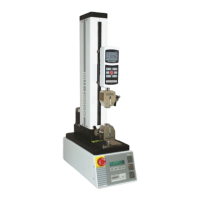Model ESM301 / ESM301L Test Stand User’s Guide
6
2.4.1 Using Grips & Fixtures with the ESM301
Ensure that the grip or fixture is positioned to ensure axial load with respect to the loading shaft of the
force gauge.
When using a grip, ensure that it secures the sample in such a way that it is prevented from
slipping out during a test, preventing a potential safety risk to the operator and others in the vicinity. If
using a grip or fixture from a supplier other than Mark-10, ensure that it is constructed of suitably rugged
materials and components.
2.5 Connecting power
Plug one end of the power cord into its receptacle at the rear of the stand and the other end into a wall
outlet with local earth ground (3-prong connector).
Before turning on power, the following safety checks and procedures should be performed:
1. Never operate the test stand if there is any visible damage to the power cord or the test stand
itself. The ESM301 is powered by 110V/220V. Any contact with this high voltage can cause
serious injury or even death.
2. Ensure that the test stand is kept away from water or any electrically conductive liquids at all
times.
3. Make sure the electrical outlet powering the test stand has local earth ground (3-prong
connector).
4. The test stand should be serviced by a trained technician only. Power must be disconnected
before the column covers are removed.
After the above safety checks and procedures have been performed, the test stand may be powered on
and is ready for operation.
3 OPERATION BASICS
3.1 Operational Safety
The following safety checks and procedures should be performed before and during operation:
1. Always consider the characteristics of the sample being tested before initiating a test. A risk
assessment should be carried out beforehand to ensure that all safety measures have been
addressed and implemented.
2. Wear eye and face protection when testing, especially when testing brittle samples that have the
potential to shatter under force. Be aware of the dangers posed by potential energy that can
accumulate in the sample during testing. Extra bodily protection should be worn if a destructive
failure of a test sample is possible.
3. Keep away from moving parts of the test stand. Loose articles of clothing should not be worn. Long
hair should be covered to avoid a hazardous situation. A Crush Hazard warning label is located on
the base of the test stand. It appears as follows:
Definition: Keep any body parts and clothing clear of the area between the base of the test stand and the
moving crosshead.

